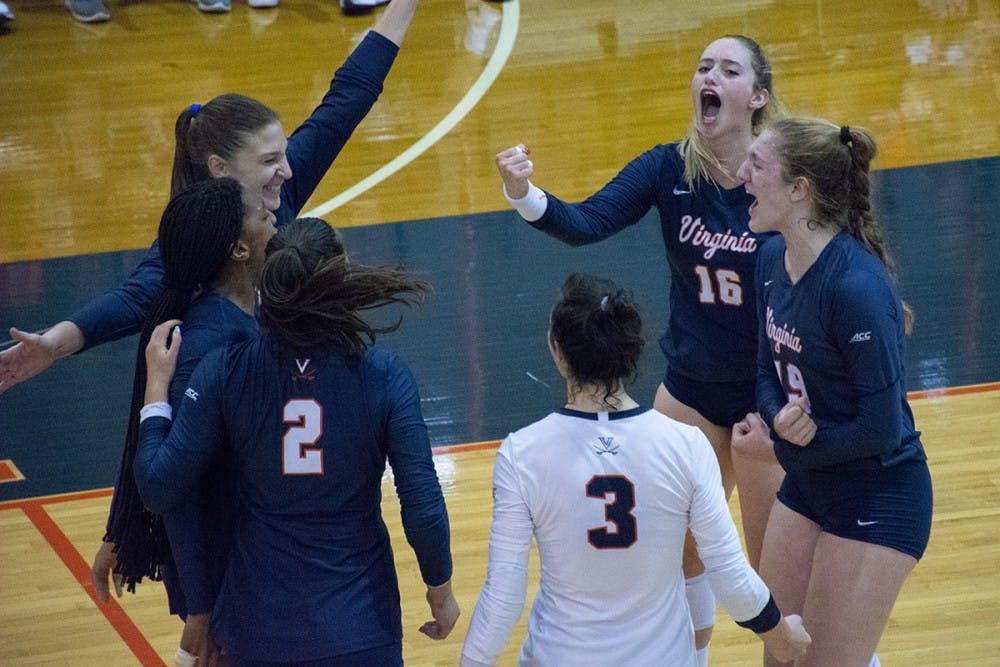If you were to take a peek at the Virginia women’s volleyball team’s record (5-11, 1-5 ACC), you would probably say that the squad has been struggling this season. If you knew, though, that the Cavaliers have only won one game in the past 30 days and have the worst record in the ACC, you might even begin to use phrases like “dire situation” and “hopeless season.”
While it’s true that when you look at the Cavaliers at a glance, it’s clear that they have had their fair share of troubles. A closer look at the team, however — both statistically and on the court — reveals an entirely different story.
First, despite sitting at the bottom of the ACC standings, Virginia is not statistically last in any major category. In fact, Virginia’s worst statistical area is kills — the team is currently at 12.50 per set. But even then, the Cavaliers are ahead of North Carolina and Wake Forest — both of which have better records than Virginia.
In blocks, assists, digs and hitting percentage, Virginia continues to perform better than at least three other ACC teams thus far. Virginia particularly excels at service aces, ranked No. 7 in the conference with 1.26 per set.
Digging even deeper, the Cavaliers look particularly good when you consider how other teams have struggled against them. Virginia has held opponents to 12.61 digs per set — No. 5 in the ACC — as well as 12.16 kills and 11.24 assists per set (No. 7 and No. 6 in the ACC, respectively). In other words, the Cavaliers have not made it easy for the teams they play, even if the score line doesn’t always reflect that.
Admittedly, numbers don’t always tell the whole story in sports — some aspects of the game can only be properly assessed in person. That being said, in many ways, the Cavaliers also the pass the eye test.
Virginia’s effort, passion and resilience — especially in Memorial Gym — are clear and electrifying. Even against higher-ranked opponents or in challenging situations, the Cavaliers rarely cower in front of competition.
The late September matchup against Florida State is a perfect example of Virginia’s intangible qualities. The Seminoles, led by junior outside hitter Payton Caffrey, went into the game on the back of a pair of straight-set victories — looking to cruise to another ACC win. Instead, in front of a buzzing home crowd, the Cavaliers made the Seminoles sweat, especially in the second set.
Sophomore middle blocker Tiana Jackson’s kill pushed the Seminole lead to 16-10 as it seemed like Virginia might lose control of the set. However, the Cavaliers responded with an incredible 10-4 run – capped off by an ace from junior right-side hitter Jelena Novakovic — that tied the game at 20-20. The run included kills from six different Virginia players as the team struck exactly when they needed to.
Many teams in that position might become demoralized or start looking towards the future. The Cavaliers, however, gave the crowd something to cheer for as they took a true ACC powerhouse to the brink of the set.
Throughout the entire game, in fact, Virginia showed off its toughness — running and diving to save plays and producing powerful swings for kills when it looked like the Cavaliers were on the back foot. Regardless of who they play against, they are a legitimately deadly team — when they have the momentum.
With all that being said, it seems perplexing that Virginia’s record is so poor — especially the fact that it only won a single set across its first four ACC games. However, the Cavaliers’ record becomes a little more understandable when you consider the level of competition they have faced and some of the weaknesses they have struggled with.
Pittsburgh, Virginia Tech, Florida State, Miami, Syracuse, and Boston College — the six teams Virginia has played since conference play began — have a combined record of 68-28 this season. That’s a winning percentage of over 70 percent which dwarfs the ACC average of 58.6 percent. In other words, Virginia has had to face very stiff competition so far within their conference.
Additionally, while Virginia’s ability to limit its opponents’ kills and digs is impressive, its tendency to produce more errors effectively neutralizes it. For instance, in the Cavaliers’ games against Florida State and Miami, they produced a combined 47 errors across both. In contrast, their opponents only had 29 errors — a difference of 18. It’s exactly for this reason that Virginia had subpar hitting efficiency against the Seminoles and Hurricanes with percentages of 0.167 and 0.153, respectively.
While Virginia has certainly struggled, its win against Boston College this past weekend exemplifies what the Cavaliers are capable of when they are firing on all cylinders. Defensively, the Cavaliers were stuffing the Eagles’ attacks constantly, ending the night with a stellar 19 blocks — Virginia’s highest rejection total since 2007 and fourth-highest all-time. The Cavaliers’ attack was more dynamic than ever with three different players recording 15 or more kills and Virginia holding a 70-58 advantage in kills. If Virginia can replicate its performance against Boston College in future games, the Cavaliers could develop into a legitimate threat in the ACC.
Moving forward, Virginia fans shouldn’t be surprised if the Cavaliers begin to win games at a much higher rate. With teams like North Carolina, Wake Forest and Clemson left on the schedule, the Cavaliers will have ample opportunity to add to their win total. If Virginia can also address its shortcomings, the squad could potentially even pull off some upsets.
Regardless of their current record and standing, the Cavaliers — both objectively and subjectively — have been an exciting team that have already produced some memorable moments. Hopefully soon, their win-loss record will match their performance and work on the court.
Vignesh Mulay covers volleyball for The Cavalier Daily. He can be reached at mulayvignesh@gmail.com or followed on Twitter @vigneshmulay.





